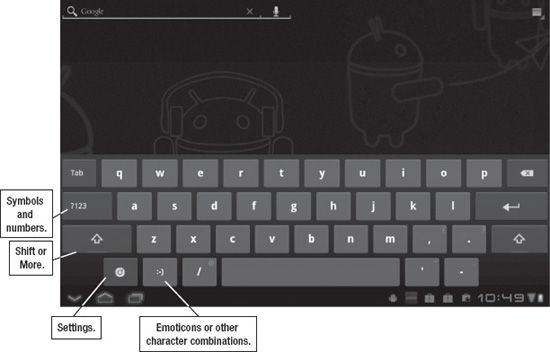The Standard Keyboard Layout
On tablets using Honeycomb, the standard keyboard layout looks something like Figure 3–1. Some keys may vary slightly, depending on the context of the text field. For instance, the Emoticon combination key may become a .com key when you open an email app.

Figure 3–1. The standard keyboard layout in Honeycomb
NOTE: The keyboard layout in Gingerbread and earlier versions of Android was slightly different. The Delete button was on the lower right of the keyboard, and the Emoticon icon appeared on the bottom-right row. Modified Android tablets may also have modified keyboard layouts.
Displaying Capital Letters, Numbers, and Symbols
To make more room for keys and allow for faster typing, the virtual keyboard hides a few of the less-used characters. On physical keyboards, you often hold two keys at once, such as the Shift and B keys to form a capital B; however, this is a bit trickier on tablets. On Honeycomb, you can also tap keys sequentially instead.
Some sequential combinations are where you'd expect to find them, such as the Shift key, ![]() which is tapped for capital letters. Tap once for a single letter. Tap a second time for caps lock, and then tap again to resume lowercase letters. The 123? key shows numbers and symbols, and tapping the More key reveals even more symbols. Figure 3–2 shows the keyboard combinations for Honeycomb.
which is tapped for capital letters. Tap once for a single letter. Tap a second time for caps lock, and then tap again to resume lowercase letters. The 123? key shows numbers and symbols, and tapping the More key reveals even more symbols. Figure 3–2 shows the keyboard combinations for Honeycomb.

Figure 3–2. Entering special characters in Honeycomb
Character Combinations and Long-Presses
You may notice the key to the left of the Slash key types more than one character at a time. It can also change, depending on where you're typing. When you type email addresses, it may become a .com key; however, when you type within the body of that email message, it may transform into a :-) or Emoticon key.
That's very convenient if you're writing to a .com address; however, what if you're writing to a .net address, and you want to type a sad face in your message instead of a smiley? If you press and hold (also known as a long-press), you'll see more key combinations for different emoticons or first-level domains. Figure 3–3 illustrates some of these combinations. Simply long-press and then slide your finger to the appropriate choice.

Figure 3–3. Long-pressing an emoticon reveals more options
But wait, there's more! What if you want to type a ü or make a proper é with an accent above it? Long-press on the vowels, and you'll see options for common foreign characters. A few consonants also have extra options, such as the ñ from the n key and the ç from the c key.
You might also notice that some keys have another character on the upper left. Rather than pressing a Shift key to reach them, you can just long-press the character itself. The Slash key (/) becomes an At Sign key (@), and the Comma key (,) becomes an Exclamation Point key (!). Once you get used to this system, it's easy to type what you need.
